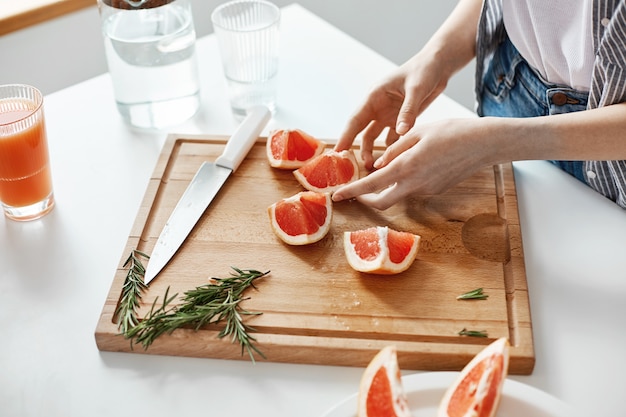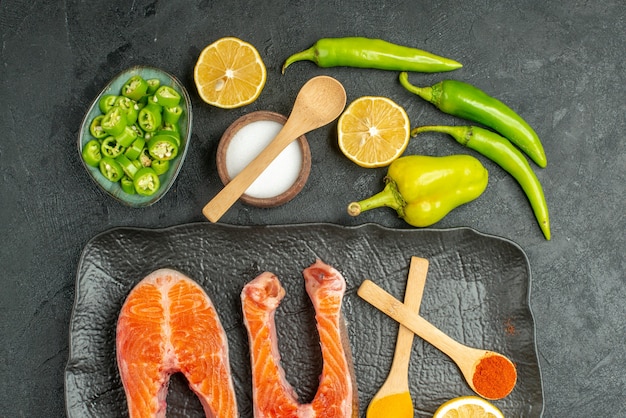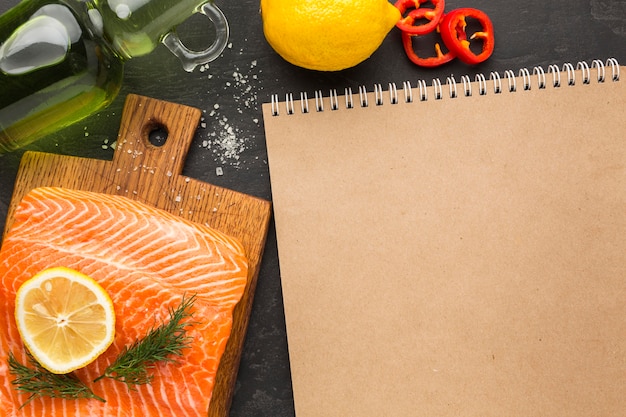Let's be honest, salmon is a kitchen hero. It's a crowd-pleaser, a healthy choice, and it can be dressed up or down for any occasion. But, let's face it, getting salmon just right can be a bit of a culinary tightrope walk. You want that beautiful flaky texture, that vibrant golden crust, and that moist, juicy center. That's where I come in, my friends. I've been baking salmon for years, and I'm ready to share my secrets for achieving oven-baked salmon nirvana.
Today, we're diving headfirst into the 400-degree world of oven-baked salmon. We're going to talk about the best salmon for the job, how to prep it for maximum flavour, and exactly how long to bake it for that perfect result. We'll even cover some handy troubleshooting tips and a few tasty variations to keep things interesting.
(Part 1) Salmon 101: Choosing the Right Fish for the Job

First things first, let's talk about the star of the show: the salmon. There are two main players in this game: atlantic salmon and pacific salmon. Now, both are fantastic, but Atlantic salmon is usually more readily available and a bit more budget-friendly, so we'll be focusing on that today.
The Atlantic Salmon Advantage
Atlantic salmon is a classic for a reason. It's got a firm texture that holds up well to baking and a flavour that's both delicate and satisfying. You can find Atlantic salmon in a variety of cuts, from whole fillets to individual portions. For oven baking, I usually opt for fillets that are around 1-1.5 inches thick. This size ensures even cooking and prevents the salmon from getting too dry.
Fresh vs. Frozen: A Matter of Preference
Honestly, I'm a firm believer that fresh is best. If you can find fresh salmon from your local fishmonger, go for it. It's just bursting with that fresh-from-the-sea goodness. But, if you're going the frozen route, that's perfectly fine too! Just make sure to thaw it thoroughly in the refrigerator before you start cooking. This will ensure the salmon cooks evenly and prevent it from being icy in the middle.
(Part 2) The Magic of 400 Degrees: A Temperature Sweet Spot

Now, let's talk about that crucial temperature – 400 degrees Fahrenheit (200 degrees Celsius). This is my magic number for oven-baked salmon. It's a sweet spot that delivers that beautiful, golden-brown crust while keeping the inside moist and tender. It's a bit of a culinary balancing act, but it always works!
Preheating Your Oven: A Non-Negotiable Step
Don't even think about skipping preheating your oven! Preheating is essential for ensuring that the salmon cooks evenly and consistently. It gives the oven a head start, creating a stable temperature environment for your fish to cook in. It's a small step that makes a big difference.
(Part 3) Preparing Your Salmon for a Flavor Explosion

Once you've got your salmon prepped and ready, it's time to get creative with flavour! This is where you can really personalize your dish and create a flavour bomb that'll leave your tastebuds singing. We're talking about seasonings, marinades, and those little finishing touches that make all the difference.
Seasoning Essentials: Simple Yet Effective
I'm a big fan of simple seasonings. Salt and pepper are your absolute best friends. They enhance the natural flavours of the salmon without overpowering them. But, feel free to experiment! Lemon zest, garlic powder, dried herbs – they all add depth and complexity to the flavour profile. Even a sprinkle of paprika or smoked paprika for a hint of heat can add a nice touch.
Marinades: The Secret to Intense Flavour
For a more intense flavour boost, consider a marinade. A simple mixture of olive oil, lemon juice, and fresh herbs is a classic choice. You can also get creative with soy sauce, honey, a touch of chili, or even a hint of ginger. The key is to let the salmon marinate for at least 30 minutes, but for a deeper infusion of flavour, up to a couple of hours can do wonders.
Finishing Touches: Elevate Your Salmon with Herbs and Citrus
For an extra burst of flavour and visual appeal, add some fresh herbs like dill, parsley, or chives right before baking. Slicing a lemon or lime and placing it on top of the salmon adds a touch of freshness and keeps it moist while it cooks. It's all about those little details that make your salmon a culinary masterpiece.
(Part 4) Baking Time: The Key to perfect salmon
Now that your salmon is prepped and ready to go, it's time to get baking! This is where we need to talk about the most important element of the process: cooking time. Remember, we're aiming for a flaky, moist salmon with a beautiful golden crust, so let's get specific.
The Golden Rule: 10-12 Minutes at 400 Degrees
For 1-inch thick salmon fillets, the general rule of thumb is 10-12 minutes at 400 degrees. But remember, this is just a guide! The actual cooking time can vary depending on the thickness of your salmon and your oven's unique personality.
The Fork Test: Your Salmon's Best Friend
The fork test is your ultimate weapon for determining doneness. Simply insert a fork into the thickest part of the salmon. If it flakes easily and the center is no longer translucent, you're good to go! If it still feels a bit firm and the centre is still pink, it needs a few more minutes in the oven. But, be careful not to overcook it, or you'll end up with dry, tough salmon.
The Visual Cue: Look for a Golden Crust
Another way to tell if your salmon is cooked is to look for that beautiful, golden-brown crust that forms on top. It's a good indication that the salmon is cooked through. But, don't rely solely on visuals, always check for doneness with the fork test.
(Part 5) Rest and Serve: Bringing Your Salmon to Life
You've baked your salmon to perfection, but don't rush to serve it just yet! Let it rest for a few minutes to redistribute those delicious juices. This crucial step will result in a more tender and juicy final product.
The Importance of Resting
Let the salmon rest on a plate for about 5-10 minutes before serving. During cooking, some of the juices are drawn to the surface, but resting allows them to reabsorb back into the fish. This creates a juicier, more flavourful salmon that's truly a delight.
Serving Your Salmon with Style
Now, it's time to let your creativity shine! Serve your oven-baked salmon on a bed of rice, quinoa, or roasted vegetables. A simple salad with a vinaigrette dressing adds a touch of freshness. Don't forget a squeeze of lemon juice or a drizzle of olive oil to enhance the flavour. And if you're feeling fancy, a dollop of sour cream or crème fraiche adds a luxurious touch.
(Part 6) Beyond the Basics: Adding a Touch of Adventure
Okay, you've mastered the basic oven-baked salmon, but let's spice things up! Here are a few variations that will add a touch of excitement to your salmon game.
Lemon and Dill Salmon: A Classic Combination
This is a classic for a reason. The bright flavour of lemon and the fresh taste of dill complement the salmon perfectly. Simply rub the salmon with lemon zest, season with salt and pepper, and top with fresh dill before baking. It's simple, elegant, and incredibly delicious.
Honey Garlic Salmon: Sweet and Savoury Perfection
For a sweet and savoury flavour bomb, try honey garlic salmon. Combine honey, garlic, soy sauce, and a touch of ginger for a marinade. Let the salmon marinate for at least 30 minutes, then bake as usual. The honey adds a touch of sweetness, while the garlic and ginger create a complex and flavourful glaze.
Spicy Salmon with Chipotle Peppers: A Burst of Heat
If you enjoy a bit of heat, try spicy salmon with chipotle peppers. Combine chipotle peppers in adobo sauce, lime juice, and cumin for a marinade. Let the salmon marinate for at least 30 minutes, then bake. This recipe delivers a smoky, spicy kick that will tantalize your taste buds.
(Part 7) leftover salmon: Turning Waste into Delights
Let's be real, sometimes you end up with leftover salmon. But don't despair! Leftover salmon is a blank canvas for culinary creativity. Here are a few ways to put those delicious leftovers to good use.
Salmon Salad: A Light and Refreshing Choice
A salmon salad is a light and refreshing way to use leftover salmon. Simply flake the salmon and combine it with your favourite salad ingredients, like greens, chopped vegetables, and a vinaigrette dressing. You can even add some crumbled feta cheese or toasted almonds for a touch of extra flavour.
Salmon Pasta: A Hearty and Satisfying Meal
For a hearty and satisfying meal, try salmon pasta. Combine flaked salmon with cooked pasta, a creamy sauce, and your favourite vegetables. You can use a simple olive oil and lemon sauce or a richer alfredo sauce. Add a sprinkle of parmesan cheese for that extra touch of flavour.
Salmon Sandwiches: A Quick and Easy Lunch
For a quick and easy lunch, make salmon sandwiches. Simply spread some cream cheese or hummus on your favourite bread, add flaked salmon, and top with your favourite toppings, like lettuce, tomato, and onion. This is a perfect on-the-go lunch option that's both satisfying and delicious.
(Part 8) Troubleshooting: Tackling Common Salmon Baking Challenges
Even the best cooks have their off days. Sometimes, your salmon doesn't turn out quite the way you hoped. But don't worry, there are solutions to common baking problems! Here's what to do if you encounter any issues.
Dry Salmon: The Moisture Issue
If your salmon is dry, it's likely that you overcooked it. The key to preventing dry salmon is to keep an eye on the cooking time and use the fork test to check for doneness. You can also help prevent dryness by marinating the salmon or topping it with a sauce before baking.
Undercooked Salmon: The Pinkness Problem
If your salmon is undercooked, it will still be pink in the centre. This is a safety concern, so it's important to cook the salmon through. Return the salmon to the oven for a few more minutes, checking for doneness with the fork test. Don't be afraid to cook it a little longer to ensure that it's safe to eat.
Salmon Sticks to the Pan: The Non-Stick Solution
If your salmon sticks to the pan, you might need to use a non-stick baking sheet or spray the pan with cooking spray. You can also line the pan with parchment paper to prevent sticking. Remember to preheat the oven and let the pan get nice and hot before you place the salmon on it.
(Part 9) FAQs: Answering Your Salmon Baking Questions
Here are some frequently asked questions about oven-baked salmon that I get all the time, and my answers!
What is the best way to store fresh salmon?
Fresh salmon should be stored in the refrigerator in a sealed container or wrapped tightly in plastic wrap. It will keep for 1-2 days. If you want to store it for longer, you can freeze it. Freeze salmon in a sealed container or freezer-safe bag. Make sure to thaw it thoroughly in the refrigerator before cooking.
How can I tell if salmon is fresh?
Fresh salmon should have a bright, shiny skin and a flesh that is firm and springy to the touch. It should also have a mild, ocean-fresh smell. Avoid salmon that has a strong fishy smell, a dull, discolored skin, or flesh that is soft or mushy.
Can I bake salmon with skin on?
You can definitely bake salmon with skin on. It actually helps to keep the flesh moist during baking. Just be sure to score the skin a few times to prevent it from curling up. You can also remove the skin after baking if you prefer.
What happens if I overcook salmon?
overcooked salmon will be dry and tough. It will also lose its delicate flavour. To avoid overcooking, use the fork test to check for doneness and don't cook the salmon for longer than 12 minutes at 400 degrees.
What are some good side dishes to serve with oven-baked salmon?
There are so many delicious side dishes that go well with oven-baked salmon! You can try roasted vegetables, like asparagus, broccoli, or Brussels sprouts. A simple salad with a vinaigrette dressing is also a great option. For a heartier side dish, consider rice, quinoa, or couscous.
(Part 10) The Takeaway: Mastering the Art of Oven-Baked Salmon
There you have it! Your complete guide to oven-baked salmon at 400 degrees. With a little practice and these tips, you'll be whipping up delicious, perfectly cooked salmon in no time. So go forth, my fellow foodies, and conquer the world of oven-baked salmon! Happy baking!
Everyone is watching

How to Cook Frozen Lobster Tails Perfectly: A Step-by-Step Guide
RecipesLobster. Just the word conjures up images of lavish meals, special occasions, and a taste of luxury. But let's...

Pork Fillet Cooking Time: How Long to Cook It Perfectly
RecipesPork fillet, or tenderloin as it's sometimes called, is a real favourite in our house. It's so versatile, and...

Pigs in a Blanket Cooking Time: How Long to Bake for Perfect Results
RecipesAh, pigs in a blanket. Just the name conjures up images of those delightful little parcels of crispy pastry en...

The Ultimate Guide to Cooking Delicious Frankfurters
RecipesLet's face it, we all love a good frankfurter. It's a classic, simple, and always satisfying. But let's be rea...

Wolf Meat Recipes: A Guide to Cooking Wild Game
RecipesLet's be honest, you don't see wolf meat at your local butcher shop every day. It's a bit of a wild card, but ...
